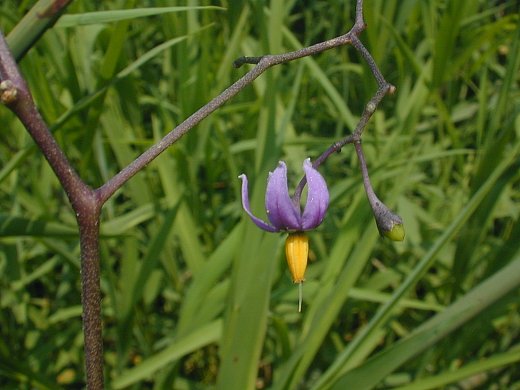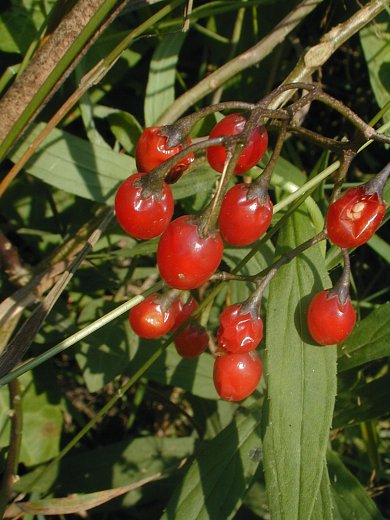Description: This perennial plant is a semi-woody vine about 2-8' long. It can become semi-erect by climbing over adjacent vegetation or fence rows, otherwise it sprawls along the ground. The stems are initially purple and slightly pubescent, or they have scattered appressed hairs. Later, they become brown and woody. These woody stems are semi-hardy in Illinois and may survive some winters to produce foliage. The alternate leaves are up to 4" long and 2½" across. The larger leaves have a triangular outline and 3 deep lobes. These lobes are broadly ovate or cordate, with the terminal lobe being much larger than the side lobes. The margin of each leaf is smooth, while the upper surface is either glabrous or has scattered appressed hairs. The terminal lobe tapers gradually into an elongated tip. The smaller leaves often lack lobes and have an ovate shape, otherwise they are quite similar to the larger leaves. The foliage exudes a rank bitter odor, particularly when the leaves or stems are damaged. Occasionally, angular clusters of 6-12 violet flowers are produced from the stems or the axils of the leaves. The flower buds and their branching stalks are also violet.

Each flower is
about 1/3" (8 mm.) across, consisting of a purple corolla with 5
triangular
lobes, several yellow anthers that are united together to form a
slender cone, and an inconspicuous style that extends beyond the
anthers. As the lobes of the corolla unfold, they spread outward and
then curve sharply backward to expose the anthers. The small calyx is
green, purple, or brown, and has 5 shallow lobes that are well-rounded.
It is persistent and slightly pubescent. The blooming period usually
occurs during the summer and lasts 2-3 months. There is no noticeable
floral scent. Each flower is replaced by a shiny little fruit that is
oval in shape and about ¼" long. Each fruit is initially green, but
later turns yellow or orange, and finally becomes bright red. The fruit
is juicy and contains yellow seeds that are circular in shape and
flat-sided. The root system produces abundant rhizomes that become
somewhat woody with age. This plant often forms sprawling vegetative
colonies.
Cultivation:
Bittersweet Nightshade prefers full or partial sun, and moist to mesic
soil that
is loamy and fertile. However, because of its robust nature, this plant
can adapt to drier conditions and other kinds of soil. It can spread
aggressively and be difficult to get rid of because small pieces of
rhizome in the soil can regenerate new plants. It is wise to wear
gloves while attempting to remove this plant by hand as the foliage is
toxic.

Range &
Habitat:
Bittersweet Nightshade occurs primarily in the northern half of
Illinois, where it
is fairly common in most areas (especially in the NE). In southern
Illinois, however, it is less common or absent (see Distribution
Map). This species is adventive from Europe, and it also
occurs in Asia. Habitats include openings in woodlands, thickets,
marshes and bogs, brushy areas and rock piles, fence rows, gardens and
edges of yards, and miscellaneous waste areas. This plant prefers
disturbed areas, although it sometimes occurs in natural habitats.
Faunal Associations:
The flowers attract bumblebees and Halictid bees (Macior, 1967).
Through the rapid vibration of thoracic muscles, the pollen is
extracted from the flowers using "buzz pollination." Nectar is not
available as a floral reward. The foliage and roots of Bittersweet
Nightshade are attacked by several species of insects, especially leaf
beetles (Chrysomelidae). This includes such species as Epitrix cucumeris
(American Potato Flea Beetle), Epitrix
fuscula (Eggplant Flea Beetle), Epitrix hirtipennis
(Tobacco Flea Beetle), Lema
daturaphila (Three-lined Potato Beetle), Leptinotarsa decemlineata
(Colorado Potato Beetle), Leptinotarsa
juncta (False Potato Beetle), Plagiometriona clavata
(Clavate Tortoise Beetle), and Psylliodes
affinis (European Potato Flea Beetle); see Clark et al.
(2004). The foliage of Bittersweet Nighshade is toxic and
unpleasant-tasting, therefore it is rarely bothered by mammalian
herbivores, with the possible exception of White-tailed Deer. The fruits of nightshade species (Solanum spp.),
including those of Bittersweet Nightshade, are eaten to a minor extent by such birds as
the Ruffed Grouse, Wild Turkey, Gray Catbird, Hermit Thrush, Swamp Sparrow, and Sora; the Bird Table has a more
complete list of these species. Some mammals also eat the fruits of these plants,
including the Raccoon, Striped Skunk, Prairie Spotted Skunk, White-tailed Deer, White-footed
Mouse, and Deer Mouse (Martin et al., 1951/1961; Myers et al.,
2004; Hamilton, 1941). Because the seeds are able to pass through the
digestive tracts of White-tailed Deer and possibly other mammals while remaining viable, by this means they are
distributed to new locations. Because
the fruits of Bittersweet Nightshade may be toxic to humans, however, their
consumption should be avoided. As a semi-woody vine that climbs fence
rows and adjacent vegetation, Bittersweet Nightshade provides good
nesting habitat and protective cover for birds and other animals.

Photographic
Location:
The rocky slope of a drainage canal at the Windsor Road Prairie in
Champaign, Illinois.
Comments:
As a semi-woody vine with deeply lobed leaves, Bittersweet Nightshade
differs from
all other members of the Nightshade family that occur in the wild in
Illinois. It is somewhat variable in regard to the hairiness of its
stems and leaves, and there is an uncommon form with white flowers.
Because of the similarity in common names, this introduced vine should
not be confused with Celastrus scandens (American
Bittersweet) and Celastrus
orbiculatus (Oriental Bittersweet), which are long woody
vines from another family of
plants.